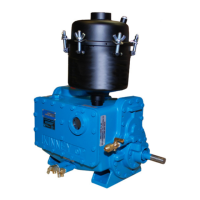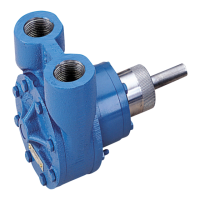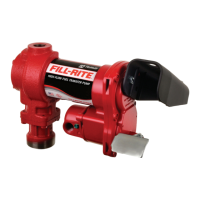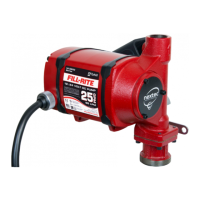Manual 1808 Rev B p/n 001808 0000
11
05
Installation
Before connecting the manifolding to the pump,
pour 1 pint (0.5 L) of oil into the inlet connection to
ensure proper lubrication at initial start-up. When
all inlet connections are made, check that the
pressure of the system is near the pump blank-off
pressure. The demountable joints should be O-ring
sealed or threaded connections made with Teon
sealing tape or other sealing compound. Loctite
567 is available from Tuthill Vacuum & Blower as
a compound for thread sizes up to 1 in. (2.5 cm) in
diameter or Titeseal (Radiator Specialty Company)
for larger thread sizes. Install a vacuum isolation
valve between the system and the pump with a
means for connecting a vacuum gauge on both
sides of the valve. The gauge connections should
face vertically down for self-draining and should be
free from the splash of the pumping action. An air
admittance valve on the pump side of the isolation
valve is recommended. With such an arrangement,
it is possible to check either the system or the pump
for leaks without disconnecting the vacuum piping.
This isolation valve will also allow the system to be
kept under vacuum while the pump is not running
or allow the pump to continue operating while the
system is open to atmospheric pressure.
VACUUM GAUGES
Two general types of vacuum gauges are used for
testing vacuum equipment: total pressure reading
types, such as Thermistor or Thermocouple
gauges, and partial pressure reading McLeod
gauges. The McLeod gauge indicates the partial
pressure of a gas and does not indicate the
component of pressure due to condensable vapors
such as water vapor. Partial vapor pressure has
little effect on the McLeod gauge readings until it
becomes quite high. Therefore, a McLeod gauge
is most useful in conrming pump performance
and for determining the absence or presence of
real leaks. Thermistor or thermocouple gauges
are preferable for leak checking, and when
used in conjunction with a McLeod gauge the
contamination level can be determined.
A high thermistor or thermocouple gauge reading
may indicate that the pump is contaminated, that
it leaks, or both. A high McLeod gauge reading
means that a real leak is present.
ELECTRICAL CONNECTIONS
WARNING
Disconnect pump from source of electrical
power prior to making repairs or adjustments
to any electric component of the unit.
Check the operating voltage of the motor
by comparing the lead connections with the
markings on the motor. Wire to the proper power
source through necessary switching and safety
equipment. Connect the solenoid valve so that it is
energized when the motor is started. The valve is
normally closed and will open when energized.
The motor must turn in the direction of the arrow
cast on the pump. If the motor turns in the wrong
direction, reverse any two of the three wires
leading from the motor to the power source.
Standard pumps are designed to run clockwise
when facing the pump pulley.
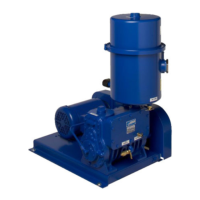
